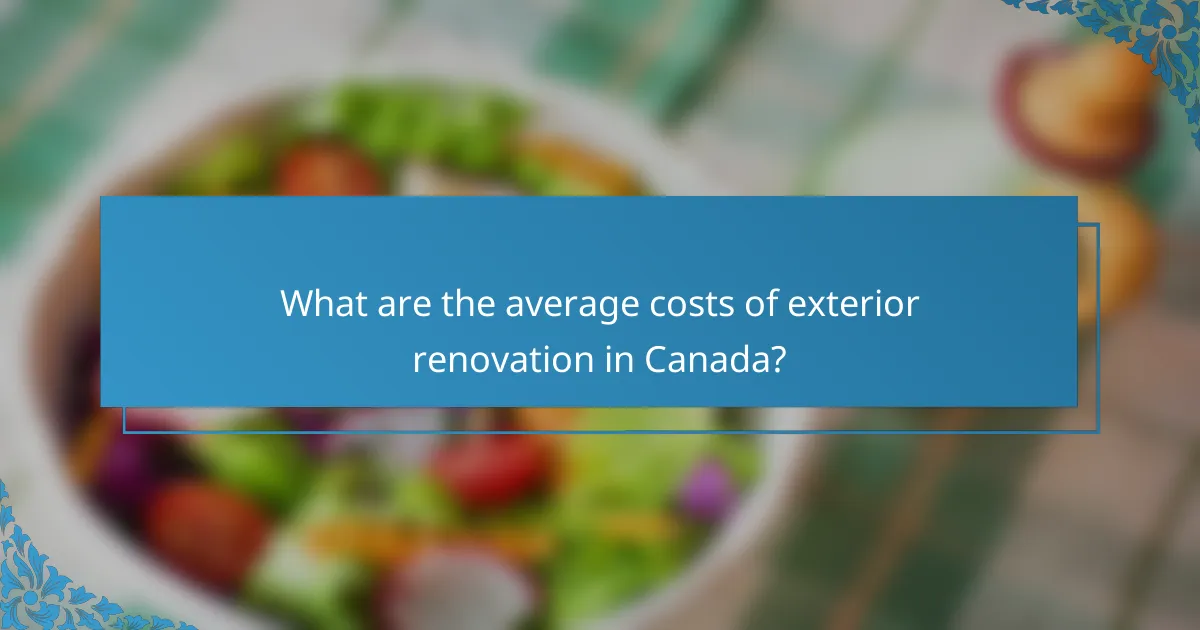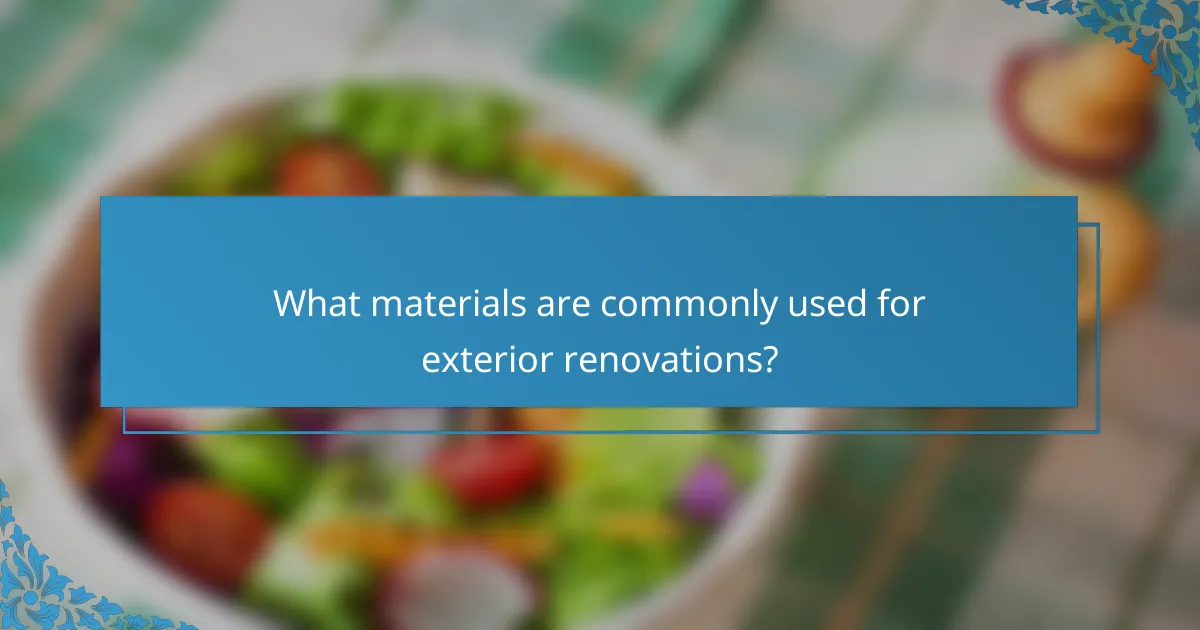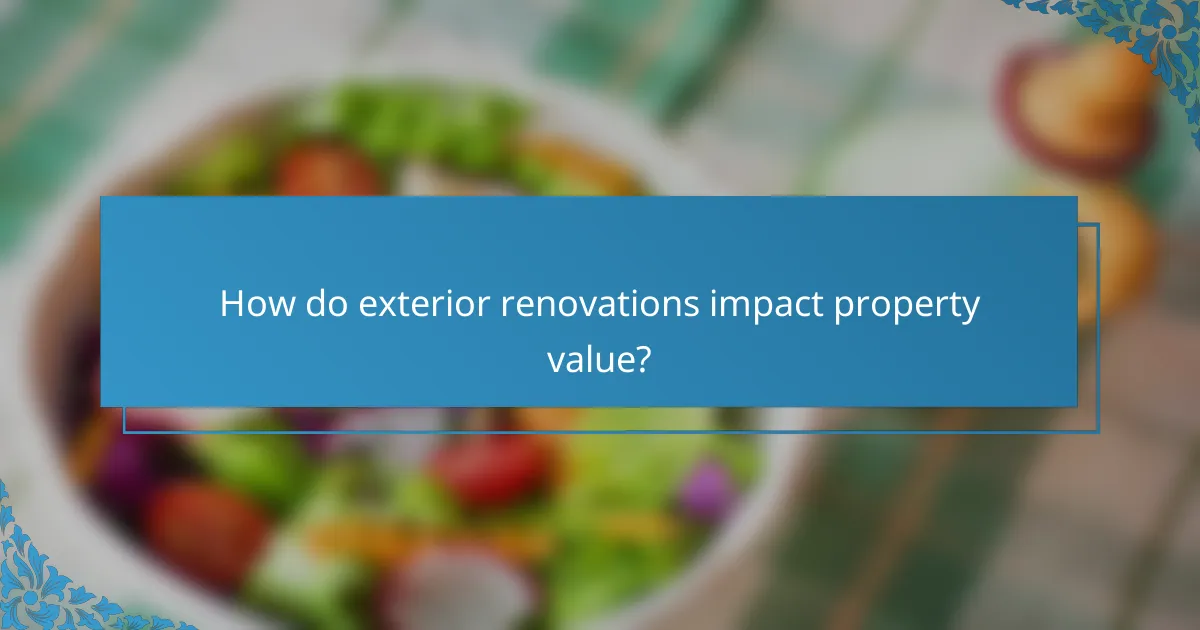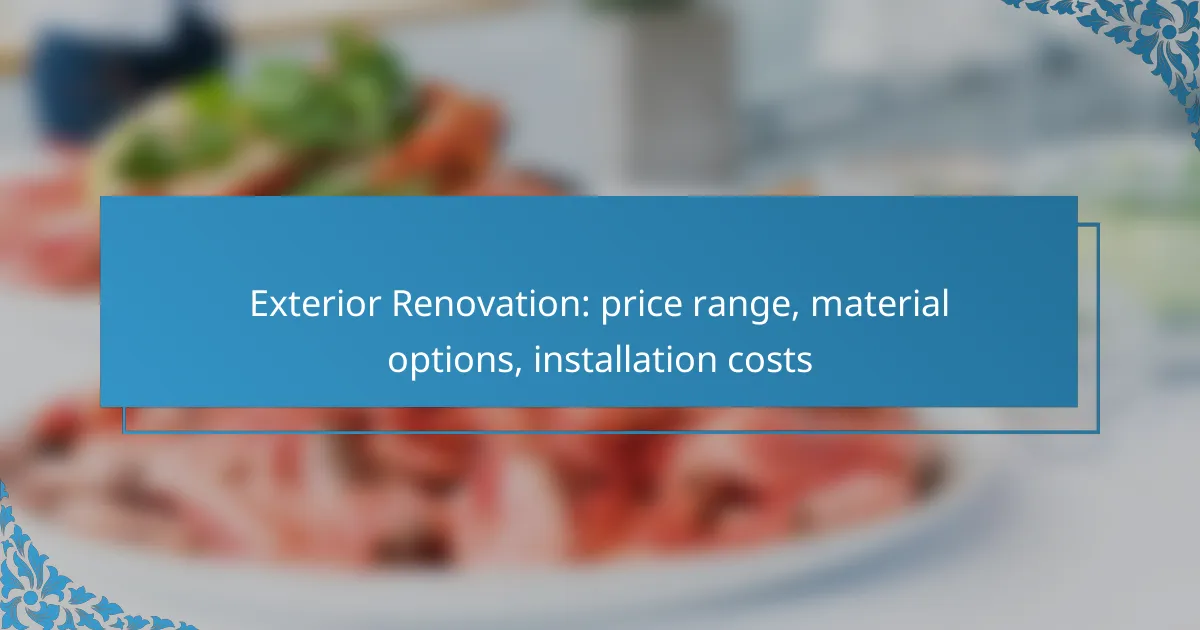Exterior renovation projects can significantly enhance a home’s curb appeal and value, with costs in Canada ranging from several thousand to tens of thousands of dollars depending on the materials and scope of work. Homeowners have a variety of material options, including vinyl siding, wood siding, and brick or stone, each offering unique advantages. Understanding the installation process is crucial for a successful renovation, ensuring that homeowners are well-prepared for each phase of the project.

What are the average costs of exterior renovation in Canada?
The average costs of exterior renovation in Canada can vary significantly based on the scope of the project, materials used, and labor costs. Homeowners can expect to spend anywhere from several thousand to tens of thousands of Canadian dollars depending on their specific renovation needs.
Cost range for residential projects
For residential exterior renovations, costs typically range from CAD 5,000 to CAD 50,000 or more. Smaller projects, such as painting or minor repairs, may fall on the lower end, while extensive renovations like siding replacement or deck building can push costs higher. It’s essential to define the project scope to get a more accurate estimate.
Homeowners should consider getting multiple quotes from contractors to compare prices and ensure they are getting a fair deal. This can also help identify any potential hidden costs that may arise during the renovation process.
Factors affecting pricing
Seasonality can also play a role; renovations during peak construction seasons may be more expensive due to higher demand. Homeowners should plan their projects accordingly to potentially save on costs.
Typical price per square foot
The typical price per square foot for exterior renovations in Canada can range from CAD 10 to CAD 100, depending on the type of work being done. For example, basic siding installation may cost around CAD 15 to CAD 30 per square foot, while more elaborate stonework could reach CAD 50 to CAD 100 per square foot.
Understanding these price ranges can help homeowners budget effectively and prioritize their renovation projects. It’s advisable to consult with professionals to get precise estimates tailored to specific project requirements.

What materials are commonly used for exterior renovations?
Exterior renovations typically involve materials that enhance the aesthetic appeal and durability of a building. Common options include vinyl siding, wood siding, and brick or stone, each offering distinct benefits and considerations for homeowners.
Vinyl siding options
Vinyl siding is a popular choice due to its affordability and low maintenance requirements. It comes in various colors and styles, allowing homeowners to achieve the desired look without frequent upkeep.
Prices for vinyl siding generally range from about $2 to $7 per square foot, depending on the quality and style. When selecting vinyl siding, consider factors like insulation value and warranty terms to ensure long-term satisfaction.
Wood siding benefits
Wood siding offers a classic and natural appearance that many homeowners appreciate. It can be painted or stained in numerous colors, providing flexibility in design.
While wood siding can be more expensive, typically ranging from $3 to $10 per square foot, it requires regular maintenance, such as painting or sealing, to protect against weather damage. Consider your local climate when choosing wood, as certain types perform better in specific conditions.
Brick and stone alternatives
Brick and stone are durable options that provide excellent insulation and require minimal maintenance. These materials can enhance a property’s value and curb appeal significantly.
Costs for brick and stone can vary widely, often starting around $10 per square foot and going up based on the type and installation complexity. It’s essential to factor in the structural considerations and potential need for a professional installation when opting for these materials.

How does the installation process work?
The installation process for exterior renovations typically involves several key steps, from initial assessment to final touches. Understanding this process helps homeowners prepare for what to expect and ensures a smoother experience.
Step-by-step installation overview
The installation of exterior renovations generally begins with a thorough assessment of the existing structure. This includes evaluating the condition of walls, roofs, and any other surfaces that will be renovated. Once the assessment is complete, the next step is to select materials and finalize designs.
After planning, the actual installation starts with site preparation, which may involve removing old materials and making necessary repairs. Following this, the new materials are installed according to the specified designs, ensuring that all elements are properly aligned and secured.
Finally, finishing touches are applied, such as painting or sealing, to enhance durability and aesthetics. Throughout the process, regular inspections help maintain quality standards.
Permits required in Ontario
In Ontario, certain exterior renovations require permits, especially for significant structural changes. Common projects that typically need permits include additions, major alterations, and new constructions.
Homeowners should check with their local municipality to determine specific requirements, as regulations can vary. It’s advisable to apply for permits early in the planning process to avoid delays.
Timeline for completion
The timeline for completing exterior renovations can vary widely based on the project’s scope and complexity. Smaller projects, like siding replacement, may take a few days to a week, while larger renovations, such as full exterior overhauls, can extend to several weeks or even months.
Factors influencing the timeline include weather conditions, availability of materials, and contractor schedules. To ensure timely completion, it’s beneficial to establish a clear schedule with your contractor and maintain open communication throughout the project.

What are the key considerations before starting a renovation?
Before starting an exterior renovation, it’s crucial to evaluate several factors that will impact the project’s success. Key considerations include selecting a qualified contractor, assessing the current condition of your property, and preparing for unexpected costs that may arise during the renovation process.
Choosing the right contractor
Selecting a qualified contractor is essential for a successful renovation. Look for professionals with experience in exterior renovations and check their references and past work. Obtain multiple quotes to compare pricing and services offered.
Ensure the contractor is licensed and insured, as this protects you from potential liabilities. A good contractor will also provide a detailed contract outlining the scope of work, timeline, and payment schedule.
Assessing property conditions
Before beginning renovations, conduct a thorough assessment of your property’s current condition. Look for any structural issues, such as damage to the foundation, roof, or walls, that may need to be addressed first.
Consider the local climate and how it affects your materials and design choices. For example, homes in areas with heavy rainfall may require specific waterproofing solutions, while those in sunny regions might benefit from UV-resistant materials.
Budgeting for unexpected costs
When budgeting for your renovation, it’s wise to set aside a contingency fund for unexpected expenses. A common recommendation is to allocate around 10-20% of your total budget for unforeseen costs that may arise during the project.
Unexpected issues can include hidden damage, changes in material prices, or additional labor costs. Being financially prepared for these possibilities can help prevent project delays and ensure a smoother renovation experience.

How do exterior renovations impact property value?
Exterior renovations can significantly enhance property value by improving curb appeal and functionality. Upgrades such as new siding, roofing, and landscaping not only attract potential buyers but can also yield a strong return on investment.
Return on investment statistics
On average, homeowners can expect to recoup a substantial portion of their renovation costs, often ranging from 60% to 80% depending on the project. For instance, replacing siding can yield returns in the upper range, while minor landscaping improvements might offer lower returns.
Specific projects like adding a deck or upgrading windows typically show higher ROI percentages, making them more appealing for homeowners looking to increase their property value. It’s essential to consider local market conditions as they can influence these statistics.
Market trends in Toronto
In Toronto, the demand for exterior renovations has been on the rise, driven by a competitive real estate market. Homeowners are increasingly investing in upgrades that enhance energy efficiency and aesthetic appeal, such as new windows and modern siding materials.
Current trends indicate a preference for sustainable materials and designs that blend with the urban environment. This shift not only reflects buyer preferences but also aligns with city regulations promoting eco-friendly construction practices. Homeowners should stay informed about these trends to maximize their renovation investments.

What are the emerging trends in exterior renovations?
Emerging trends in exterior renovations focus on sustainability, technology integration, and aesthetic versatility. Homeowners are increasingly prioritizing eco-friendly materials and smart home features while enhancing the visual appeal of their properties.
Sustainable materials usage
Sustainable materials are gaining traction in exterior renovations, driven by a growing awareness of environmental impact. Options like reclaimed wood, recycled metal, and low-VOC (volatile organic compounds) paints are popular choices that reduce carbon footprints.
When selecting sustainable materials, consider their durability and maintenance requirements. For instance, fiber cement siding offers longevity and low upkeep, while bamboo decking is both renewable and aesthetically pleasing. Prices for sustainable materials can vary widely, typically ranging from moderate to high, depending on the type and source.
To maximize the benefits of sustainable materials, ensure they meet local building codes and standards. Additionally, look for certifications like LEED (Leadership in Energy and Environmental Design) to verify the environmental claims of products. Avoid common pitfalls, such as choosing materials solely based on price without considering their long-term sustainability and performance.
